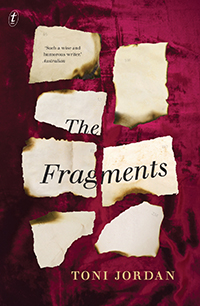Fragmented Past
The Fragments
Toni Jordan
Text Publishing, 2018
ISBN: 9781925773132
$29.99
336 pp
Many authors turn out
variations of the same book with each new offering, or a continuation of a
well-practised style and flavour. Toni Jordan is not one of these. The Fragments is fresh and very different from all her previous novels in its structure, style and story.
Actually, there are multiple stories weaving through this novel, occurring in two distinct periods and locations: 1980s Brisbane and 1930s New York. Distinct and intimately connected.
The title of the book refers to a few enticing fragments of a lost novel by a celebrated American writer of the earlier twentieth century and a display of those fragments at an exhibition in Brisbane in more modern times. The main protagonist in 1986, Caddie, meets Rachel, an older woman, at the exhibition. Rachel quotes part of a line from the lost novel that does not appear in any of the fragments yet sounds absolutely right to Caddie, who has made a long study of the author, Inge Karlsson. Rachel is the main protagonist from the 1930s.
The Fragments alternates chapters between the two places and periods. As it progresses, the two interleaved periods seem to come closer together. The mystery of Rachel quoting the unknown line prompts Caddie to delve into whether it is possible that someone rad the novel before all copies were destroyed in a fire in which Inge Karlsson and her publisher died. Or did a copy survive? Who is Rachel?
Toni Jordan paints vivid pictures of both cities in their respective periods. Apart from socially forbidden relationships and sexual exploration, she brings in pre-War 2 fascist politics and 1980s Australian university intrigue and manipulation.
It is always a question for me, when a novelist has a novelist as a character in her book, how much of herself she sees in that character. In a conversation between Rachel and Inga in 1938 New York, they have the following conversation:
“Sitting at my lonesome desk, toiling every day for the greater good,” Inge says.
“… I didn’t imagine you in a place like this,” Rachel tells Inge.
“But this is the best place to be … At home there’s just you and your thoughts. Your bright, white, unsullied pages. Out on the street, there’s always the danger that someone will see you. Sometimes that’s fine, sometimes I’m in the mood for that. But usually I just want to be by myself.”
As a writer, I enjoy time by myself, although it’s actually time with my characters. It has occurred to me that, for a writer, this may be equivalent to being online, on social media, although my connection with my characters can seem more real.
Toni Jordan is wonderful in taking the reader right into a scene with vivid descriptions, such as this one of Inge’s apartment in New York:
“A cream and blue Chinese rug covers much of the parquetry, and the chairs – some green velvet with tortured arms and legs, others with tapestry seats and armrests and backs like soldiers – are standing stiff against the cream-papered walls. Heavy oil portraits of angry or dead-eyed women glare across the room. The far windows, framed with chintzy scalloped curtains, are sealed tight but the view [Rachel] glimpses would be glorious across the East River to Roosevelt Island and maybe as far as Astoria; trees turning red and amber and gold. Rachel’s shoes click on the floor; Inge is barefoot, each nail a tiny silver shell.”
The Fragments is a delight in every possible way: its language, the mystery and intrigue, the intertwining of disparate times and places, romance and sex, dishonesty and possible redemption, politics and social upheaval; it has it all but Toni Jordan never lets it run away into a mess. She is in control of her craft and uses it to show what a superb storyteller she is.
[to receive an email each time a new review is posted, email me: <daan [dot] spijer [at] gmail [dot] com>]
 CLICK HERE to download a formatted PDF of the above post
CLICK HERE to download a formatted PDF of the above post
 See more of Daan Spijer’s writing and his photos at Seventh House Communications and at Medium.com
See more of Daan Spijer’s writing and his photos at Seventh House Communications and at Medium.com
